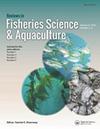Stock Enhancement in Greenlip Abalone Part I: Long-Term Growth and Survival
引用次数: 13
Abstract
A cohort of Haliotis laevigata, spawned from wild broodstock, was monitored from settlement at a hatchery until age 8. Animals were released into the wild at 31 mm (± 4 SD), targeting an enhancement size-class of 135–145-mm shell length. Release densities were tailored to match wild-stock densities using a size-dependent mortality model. A total of 7,500 animals were released into 24 sites, and each site was precisely mapped to control release densities. Environmental and husbandry factors were also quantified. Initial survival rates (six months post-release) differed significantly among sites (range: 11–67%) but not beyond this time period. Legal minimum length (140 mm) was achieved, on average, at 5 years of age or 3.5 years post-release, and the cohort entered the fishery over 3 years (age 5–8). Cumulative survival at age 5 varied between 20% at the better sites and 6% at the worst sites, with an average of 13%. Water depth was significantly positively correlated with growth (r = 0.47; p < 0.05), but no other ecological variables influenced growth or survival. Husbandry factors were implicated in sites with poor survival, but this was not confirmed statistically. The cohort successfully entered the fishery and was harvested at an overall fishing mortality (F) of 0.27, but site differences in F were significant and highly correlated with growth.绿唇鲍鱼种群增养第一部分:长期生长和生存
从一个孵化场定居到8岁,对一群由野生种鱼孵化而成的黑盘虫进行了监测。动物在31 mm(±4 SD)时被释放到野外,目标是增强尺寸等级为135 - 145 mm的外壳长度。使用大小依赖的死亡率模型,调整释放密度以匹配野生种群密度。共有7500只动物被释放到24个地点,每个地点都被精确地绘制了地图,以控制释放密度。环境和畜牧业因素也被量化。初始存活率(释放后6个月)在不同地点之间有显著差异(范围:11-67%),但超过这段时间后没有差异。法定最小长度(140毫米)平均在5岁或释放后3.5岁时达到,队列进入渔场超过3年(5 - 8岁)。5岁时的累积存活率,较好部位为20%,最差部位为6%,平均为13%。水深与生长呈显著正相关(r = 0.47;P < 0.05),其他生态变量均不影响生长和存活。畜牧业因素与生存率低的地区有关,但这没有得到统计上的证实。该队列成功进入渔场,并以0.27的总体捕捞死亡率(F)收获,但F的地点差异显著,且与生长高度相关。
本文章由计算机程序翻译,如有差异,请以英文原文为准。
求助全文
约1分钟内获得全文
求助全文

 求助内容:
求助内容: 应助结果提醒方式:
应助结果提醒方式:


